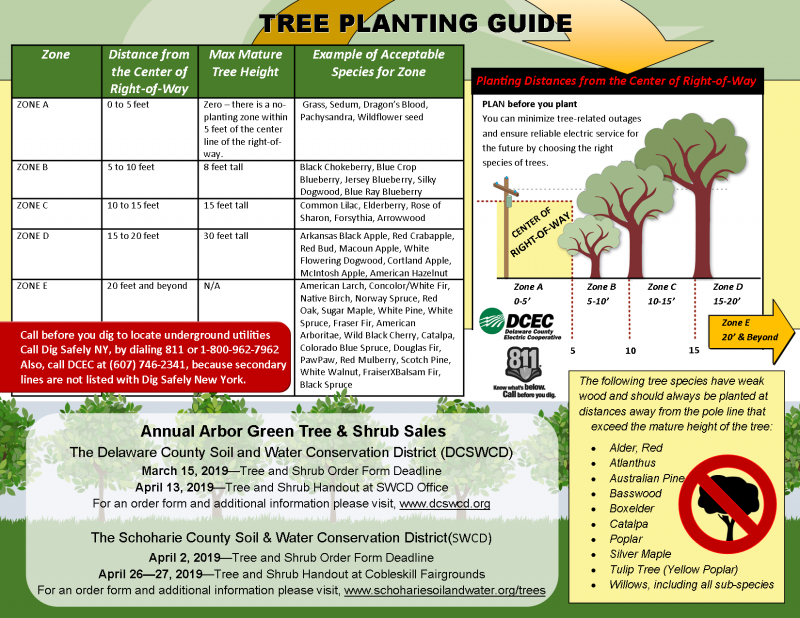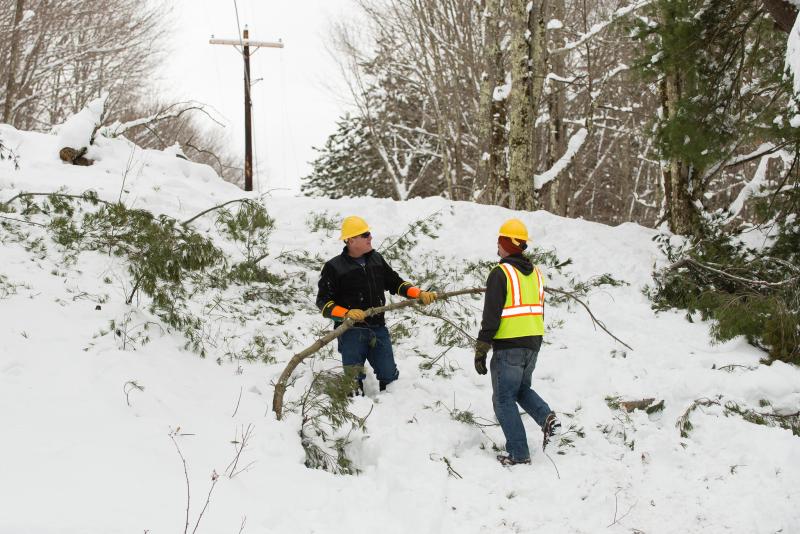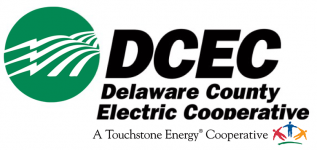Are you looking for ways to help improve the restoration time and safety of our Cooperative? There are several factors that contribute to the damage assessment and restoration process once an outage occurs. The Cooperative is always keeping in the mind the safety of our personnel, members, and the general public before proceeding with gathering information and determining the extent of the damage in the affected areas. Your telephone call reporting an outage is vital because it will be combined with other members’ calls and computer programs that will aid in the restoration and help make a prediction as to what lines or other equipment may be out of service. This helps our line crews find the locations of the outages more quickly.
Below are past newsletter articles that also help keep the Cooperative safe and help to keep reliability affordable and efficient:
Planting & Trimming Trees Near the Cooperative Line
DCEC works very hard to keep the electric line right of ways cleared of trees and branches that can cause outages. Trees are the number one cause of outages in our very rural service territory. Our own tree crews and our contractor crews are constantly trimming and removing trees under our electric lines, in an ongoing effort to make your electric service as reliable as possible. We remove trees from the right of way, rather than trim them repeatedly over the years. However, we work with our members whenever we are able to without endangering the safety of our personnel or the reliability of the system.
Our members are responsible for making sure trees aren’t growing into their secondary lines from the transformer pole to the house or to their meter pole. If limbs are getting close, contact us and we will make arrangements to trim the trees near your service wires when in the area. Never attempt to trim trees under or around our electric lines, doing so could put you at risk of deadly electrical shock.
Also, when planting trees you should plan ahead. A tiny tree today will eventually grow large enough to create safety hazards and possibly interrupt power during storms. Please use these guidelines when planting trees:
1. You should choose trees and plant them so the outer branches will never grow to within 15 feet of a power line. Check with your local nursery or Cornell Cooperative Extension for assistance in choosing the trees that fit your environment and work in concert with the electric line.
2. Avoid planting directly under power lines. Even short growth trees or shrubs create a safety concern for our line personnel. During outages, we patrol on foot and need to have unobstructed access to assess the outage and potential problems. Many times, we need to gain access to the right of way with our vehicles to either change out a pole, install an anchor, install a mid-span splice, etc.
3. Plan ahead for plantings and give yourself an appropriate distance from not only electric lines, but from public and private roads and from your buildings as well.
4. You should keep plantings at least ten feet away from all underground electric lines. Remember, a tree’s root system is as wide as the tree is itself. If planted too close to underground cables your tree could be seriously damaged if the Cooperative or its contractor needs to dig up the cable for repair or replacement.
In any case, feel free to contact DCEC when planting around power lines so that we can help to locate underground cables and offer suggestions on planting clearances.


Does DCEC Have a Key To Your Gate?
The Electric Cooperative recognizes the importance of protecting your properties and limiting access to them by means of gates or chains. What we encourage our Cooperative members to do is to provide us with keys to your properties so that we can access them in the event of a power outage or to perform routine maintenance. Many property owners have provided us with keys or lock combinations to allow us access when we need it.
Often times we come up on a new chain or gate and have no means to gain access except to remove the gate or cut the chain to access the property. In these circumstances we remove the gate if possible or cut a link from the chain and install a repair link in its place when we leave.
If you’re a new property owner or an existing DCEC member that has installed a gate or chain, please contact us at (607) 746-2341 in regard to providing us with a key. This would be beneficial to both of us in the event of an emergency.
What You Should Know About Downed Power Lines
Always remember to stay clear of fallen utility wires. If you do come in contact with a downed utility wire of any kind, always do the following:
1. Assume it's energized and stay as far away as you can. Energized lines can charge the ground near the point of contact and may electrocute you. If a person or pet comes into contact with a downed power line, remain clear. Do not touch them or the wire.
2. Call 911 or the utility serving the location. Leave everything to utility professionals and emergency personnel.
3. Do not drive over downed power lines. Even if they're not energized, downed wires can get entangled with your vehicle and cause further damage.
4. Stay in your car. If a power line falls on your vehicle while you're driving, do not exit until you know for sure that the line is de-energized.
5. If you must evacuate, jump away and land with both feet together. Do not touch the vehicle while stepping on the ground, as this can create a path for electricity to run through you.
6. Shuffle away to safety. Keep your feet together and take small, shuffling steps until you're at least 35 feet away. Taking larger steps can also create a path for electricity to run through you.
7. Phone and television wires can be just as dangerous as electric wires. Treat all downed wires as shock hazards.

Dangers of Unauthorized Pole Attachments
Do you have a satellite dish, bird feeder, clothesline or any other kind of unauthorized attachment to the Cooperative’s utility pole near you house? If you do, you are not alone. Unfortunately, these unauthorized attachments pose a threat to the safety of line workers when they must climb a pole to perform maintenance or restore power after a storm. Under OSHA regulations enacted in 2014, a line worker needs to utilize a fall restriction device that wraps around the pole as they climb. Each time a line worker reaches an unauthorized attachment, they need to remove the fall restriction device from the pole to climb past the obstruction, placing the worker at increased risk for a fall. Please do your part to keep our workers safe. If it can be done safely, remove any unauthorized attachments from the utility poles near your home. If you need help removing an attachment or you don’t know whether an attachment is authorized, call the Cooperative’s office at 607-746-2341. We would be happy to assist you.
Property Access – Thank you Landowners
The Cooperative maintains 800 miles of distribution lines across four counties in order to provide electric service to 5,387 homes and businesses. Those distribution lines run across thousands of properties owned by thousands of different landowners. On behalf of the Line Crew and Tree Crew members who perform daily maintenance and storm restoration, thank you to all the landowners who support their work by allowing access to our rights-of-way through driveways, farm roads, fields, and yards. Without you allowing them to cross your properties to access our rights-of-way, maintenance and restoration of the electric system would be impossible. Various obstacles prevent our workers from traveling directly down the rights-of-way:
- Natural features such as waterways, rock ledges, and gorges
- Stone walls
- Livestock fences
For this reason, it is often necessary for Cooperative crews and equipment to pass through private property outside of the easement area in order to accomplish their work. Thank you to all those landowners who continue the long tradition of allowing Cooperative crews to pass through your property.
If the Cooperative creates ruts or other impacts to your landscaped and/or maintained property in the process of doing our work, we are responsible for repairing the damage and returning your property to its prior condition.
Who Is Sneaking Around in My Back Yard?
When your neighbors’ lights go out, the Cooperative’s line crew may need to troubleshoot and fix the root cause of the outage on your property, even if your lights are still working fine. How is that possible? The Cooperative’s electric distribution network has up to three separate “hot” conductors at any particular point in the distribution network. We refer to the three hot conductors as “phase A,” “phase B,” and “phase C.” If some of your neighbors are connected to phase A and you are connected to phase B, their service could be interrupted by a problem with the line while your service is still working just fine. However, the problem could still be in your back yard. So, if you see DCEC crews walking through the right-of-way with flashlights when your lights are working, don’t be alarmed, it could still be our line crew restoring power for your neighbors.

